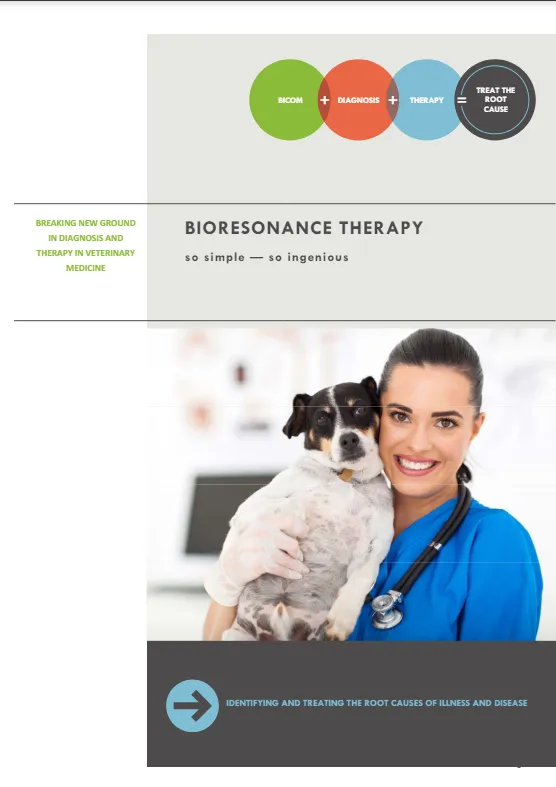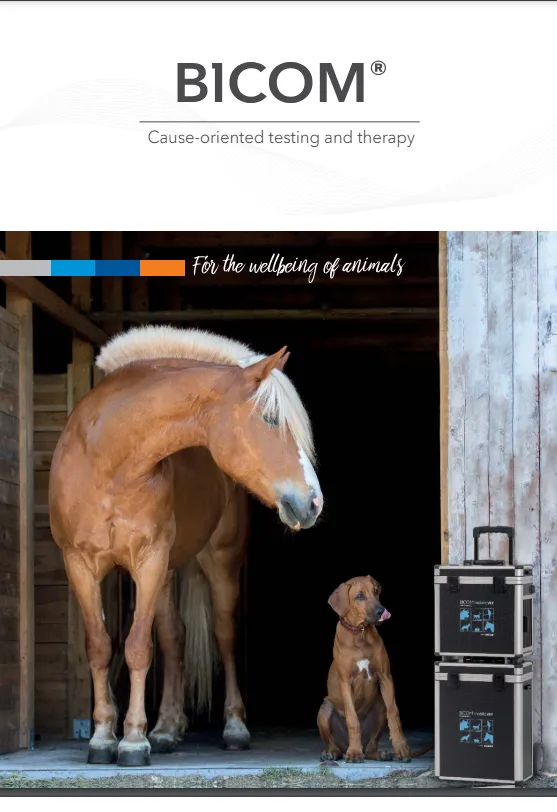BICOM® Bioresonance
Stress-free for pets and pet owners Suitable for all types of animals
There are many dogs , cats and horses suffering from health problems worldwide.
Be it problems with the musculoskeletal system, allergies and food intolerances or chronic diseases.
Sometimes, as an animal owner, you are at a loss when you can’t get any further with conventional therapy methods.
Like acupuncture or homeopathy, bioresonance belongs to the field of complementary medicine and is intended to be a useful supplement to conventional medicine.
It works with the body’s own wavelength of the four-legged friend, is used without medication and is painless to use.
Of course, not all health problems can be resolved with bioresonance. It is best to talk to a veterinarian or animal naturopath.
With our therapist finder you can find the nearest practice that can offer you BICOM® bioresonance.
Pain-free testing and therapy
Treatment with the BICOM® device is painless and stress-free. Especially sensitive animals feel very comfortable and it often happens that they completely relax and come to rest during the therapy.
Bioresonance has no harmful side effects and is used without medication.
Occasionally, initial aggravations, in what is known as the body’s initial reaction, can occur. However, these fade away after a short time.
What Pet Owners are saying..

Bioresonance therapy and skin diseases in animals
When a pimple develops or signs of aging start to appear in a person, they tend to act upon the issue promptly, opting for rather expensive products to help them get rid of the problem. When skin-related issues arise amongst their pets, however, they often fail to address the problem promptly and often tend to opt for cheaper solution that are not effective in treating the particular problem. Just like humans, animals can also suffer from a large number of skin disorders which reduces their quality of life. In some cases, skin-related condition in animals can cause irritation and even severe pain as well.
Types Of Skin-Related Conditions In Animals
Animals can develop many different kinds of skin conditions. In fact, according to PetMD, there are more than 160 skin diseases that can affect a dog alone. Cats, horses and other animals are also at risk of several diseases that affects their skin. In the simplest form, a skin disease that affects an animal is divided into two major categories, being curable and incurable. As the names suggest, curable skin diseases refers to those conditions that can be treated successfully. Incurable skin diseases, on the other hand, are those conditions where only the symptoms can be treated and the progression of the disease can be slowed through various treatment options, but the disease can never be completely cured.
What Causes Skin-Related Conditions In Animals
It is important to know what may cause a skin condition to develop in an animal to ensure the risks are kept at a minimum and to determine what may be the cause of a developed condition. There are many different skin-related conditions amongst animals, and they are caused by different factors. In some cases, external factors may be to blame and, in other cases, internal factors like infections or allergies may be to blame.
Skin Vet Clinic explains that atopic dermatitis, for example, may be somewhat influenced by the genetics of a particular animal, and the environment to which the animal is exposed to also plays a part in their risk of developing this disease. Furthermore, they also explain that the immune system plays a role in such a skin disease as well.
How Skin-Related Conditions In Animals Are Treated
Before a skin-related condition that affects an animal can be treated effectively, it is important for an official diagnosis to be done first. This will ensure that the condition is treated appropriately and not with the wrong types of medication or ointments. There are several types of tests that can be performed to diagnose a skin-related condition in a dog, cat or any other particular type of animal. A blood or saliva test may be done, as well as a test on a hair sample. Two particular types of tests that are often used to diagnose atopic dermatitis in dogs include a percutaneous prick test and an intradermal test.
After the particular type of disease that a dog has developed is diagnosed, a treatment plan can be compiled by the veterinary physician that has diagnosed the condition. The treatment plan will usually be tailored to the individual dog’s condition and will depend on the type of skin disease they have, the symptoms that have developed and how severe the condition is.
When it comes to treating skin diseases in animals, medication and topical creams are not the only treatment measures prescribed by the veterinary physician. In addition to potentially providing the pet owner with appropriate medicine to treat the condition, they will also analyze the animal’s living environment. This will help them identify any potential contributing factors that are causing the disease or aggravating the symptoms. Changes might thereafter be recommended to help reduce the symptoms.
Bioresonance Therapy And Skin-Related Conditions In Animals
In addition to adjusting some aspects in the environment where the animal resides to better accompany their diagnosed disease and administering certain medications to the dog, alternative treatments also pose as potentially effective measures to assist with easing the symptoms and improving the animal’s quality of life. Bioresonance therap, in particular, is an excellent option for pet owners who would like to speed up recovery and enhance the results achieved from treating their pet’s skin condition. Bioresonance therapy can assist with identifying potential causes within the pet’s own body, and then treat these particular causes to help cure or at least control the skin-related disease.
Conclusion
Animals are more prone to developing skin conditions than many think, and treating these conditions are important to ensure the animals can live a normal life. When skin conditions develop in animals, the animal may experience several unpleasant symptoms that may affect their quality of life in a negative way. Treating these conditions is possible, but some diseases cannot be completely cured. Bioresonance therapy is also a potential treatment measure that helps to minimize the symptoms while also targeting the underlying causes of the conditions.
To find a vet near you please complete the form below
Quick Links








Facebook
Instagram
Mail